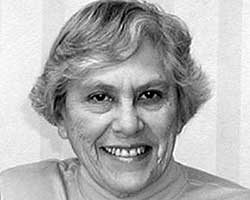Obituary: Janet Norwood’s Legacy of Objectivity
Tom Plewes, Director of the Committee on Population of the National Research Council
Federal statistical agencies are keenly aware of the need for data objectivity, which requires that data be accurate, reliable, and unbiased and presented in an accurate, clear, and unbiased manner. To be trusted, they need to be presented in a clearly nonpartisan way. No one realized this more nor did more to advance the reputation for objectivity of the critical employment, price, and wage data produced by the Bureau of Labor Statistics (BLS) than its 10th commissioner, Janet L. Norwood, who passed away due to complications from Alzheimer’s disease on March 27, 2015, in Austin, Texas, at the age of 91.
During her career at BLS and in years after her service as commissioner, Janet found many platforms for advancing the quality, integrity, reliability, and objectivity of federal statistics. She came up through the ranks at BLS, mainly in the bureau’s price programs, and was deputy commissioner when, in May 1979 and after 16 years in BLS, she was confirmed as commissioner following the death in office of Julius Shiskin and a short period of service as acting commissioner. Only one other commissioner had previously come up through the ranks, and, until Janet, no commissioner had been female. Other firsts marked her career. She was appointed by a Democratic president (Carter) and twice reappointed by a Republican (Reagan).
As commissioner, with service from 1979 to 1991, Janet’s public contribution to the objectivity of data centered on monthly open testimony on the jobs report—usually on the first Friday of each month—before the Joint Economic Committee of Congress. These monthly employment reports are among the earliest, most closely watched, and politically charged of the federal government’s indicators of the health of the economy.
The hearings had an ignoble beginning, introduced in 1971 during the tenure of her predecessor, Geoffrey Moore, when the then-secretary of labor dictated an end to monthly press conferences at which the commissioner explained the data. Shortly thereafter, Congress’s Joint Economic Committee stepped into the breach and began this series of monthly hearings to give the commissioner a platform for an impartial discussion of the statistics. Janet took full advantage of the opportunity to go to Congress and, via widespread press and TV coverage, the public each month, eventually logging 137 hearings over her 12-year tenure. Her analysis in these hearings was precise and crisp, and she took pains to avoid interpretation that might be perceived as political in tone, often side-stepping efforts by members of one party or the other to add flavor to the data releases.
Many considered these monthly appearances dry, technical affairs, but jousting over the meaning of the data often made for high theater. Janet excelled at walking a fine line and sticking to the story the data told. Her nonpartisanship and demeanor engendered trust, and that trust extended to the data, even though the estimates sometimes looked wacky on a month-to-month basis and were hard to explain.
More than surviving and enhancing the hearings, however, Janet made her mark on the bureau by initiating programs to protect and enhance the quality and scope of the its core programs. She did it despite widespread budget cuts during most of her tenure. In tackling often difficult technical problems, she insisted on that same impartiality and focus on the independent public-service role of the bureau.
Janet’s major contribution was in the significant improvements made to the sensitive Consumer Price Program (CPI). It was a time when inflation was rising substantially and great attention was paid to the CPI, but there was much controversy over its technical merits. In this time of heightened interest, Janet was able to implement revisions in the homeownership component of the CPI that improved its quality. Also on the substantive side, she implemented significant improvements in the availability and quality of data on women and minorities.
Janet served as elected president of the American Statistical Association in 1989 while serving as commissioner. In the years after she stepped down as commissioner in 1991, she continued to remain active in statistical bodies and public service venues. As a senior official at the Urban Institute, she wrote papers and testified before Congress about various political issues. She served on and chaired a number of study panels for the National Research Council’s Committee on National Statistics and was active on panels for the National Academy of Public Administration. She chaired the Advisory Committee on Leading Indicators at the NY Conference Board and served as a member of the executive committee on the board of directors of the National Opinion Research Center at the University of Chicago. In another first, she was the first woman elected as president of the prestigious Cosmos Club in Washington.
Janet leaves a legacy of commitment to objectivity, integrity, and quality of the federal government’s data that lives on today in the BLS and throughout the government.


















